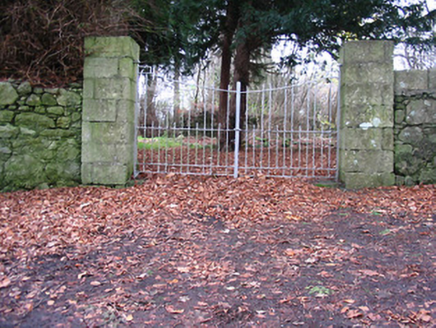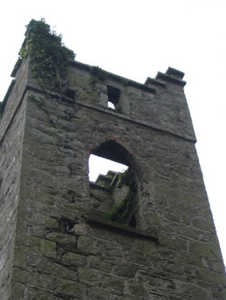Survey Data
Reg No
12318031
Rating
Regional
Categories of Special Interest
Architectural, Artistic, Historical, Social
Original Use
Church/chapel
Date
1805 - 1810
Coordinates
271106, 144004
Date Recorded
17/05/2004
Date Updated
--/--/--
Description
Remains of detached three-bay double-height single-cell Board of First Fruits Church of Ireland church, dated 1809, with single-bay four-stage entrance tower to north-west on a square plan. In use, 1903. Now in ruins with nave mostly collapsed. Pitched roof to nave now gone with roof to tower behind parapet now gone. Random rubble stone walls to nave now mostly collapsed with traces of unpainted render over, cut-limestone quoins to corners, coursed squared rubble limestone walls to tower having slight batter, cut-limestone quoins to corners, cut-limestone stringcourse to second stage, and parapet on cut-limestone stringcourse having stepped corner finials with cut-limestone coping. Openings to nave no longer discernible. Diamond window openings to second stage to tower with red brick dressings, and no fittings remaining. Pointed-arch window openings to top (bell) stage to tower with cut-limestone sills, red brick dressings, and no fittings remaining. Square-headed door opening with cut-granite block-and-start surround, fittings now missing, and cut-stone date stone over. Set back from road in own grounds with overgrown grounds to site having random rubble stone boundary wall, cut-limestone piers, and iron double gates. (ii) Graveyard to side with cut-stone markers, post-1809-post-1903.
Appraisal
Although surviving only as a fragment the remains of a modest-scale church conforming to a standard arrangement of nave and tower associated with the Board of First Fruits (fl. c.1711-1833) prevail as important evidence of the once-prosperous Church of Ireland community in Graiguenamanagh. An elegantly-profiled tower in particular forms an appealing, if increasingly-obscured landmark of some Romantic quality in the landscape. An attendant graveyard containing a collection of overgrown markers displaying good quality stone masonry further enhances the setting value of the church.













